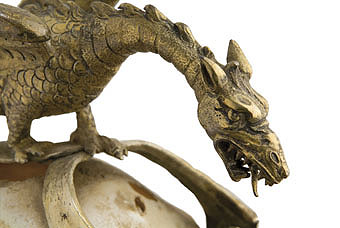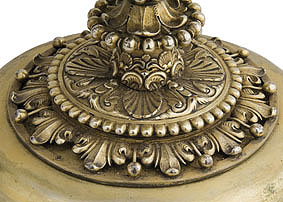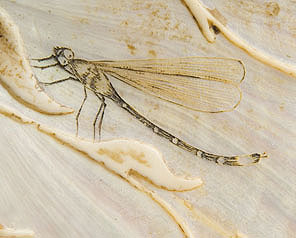The piece of the month of January 2008
THE NAUTILUS CUP OF THE MONASTERY OF SANTA MARÍA LA REAL DE FITERO
Carmen Heredia Moreno
University of Alcalá de Henares
One of the most interesting artistic objects in the monastery of Santa María la Real de Fitero is a nautilus cup from the second half of the 16th century, a unique and exceptional piece in the artistic heritage of Navarre. For several centuries it was used as a liturgical naveta, but it was originally made as a civil piece for profane use. In fact, these cups, made of nautilus shells on a silver foot and garnish, became fashionable in Europe during the second half of the 16th century and were used as ceremonial cups or with a strictly ornamental and sumptuary function in the domestic sideboards of wealthy homes. Their delicate shapes and materials made them highly valued objects due to their rare and exotic character, to the point that their presence became almost indispensable in private collections, where they usually occupied a prominent place in the "chambers of wonders" typical of Mannerist fantasy collecting.

Nautilus Cup
Until very recently, they were considered products worked entirely in European workshops from natural shell. However, according to the latest published programs of study , most of these nautiluses were imported by the Portuguese from China through the port of Canton and, apparently, the vegetal or figurative decorations on most of the shells were engraved in their place of origin. This is the case with some of the specimens in the Museo degli Argenti of the Pitti Palace in Florence.
internship In Spain several specimens are preserved in private collections, but their presence in ecclesiastical trousseaus is very scarce, either because the nautilus shell, being a very fragile and delicate material, was not very functional for a continuous and persistent use and manipulation in liturgical ceremonies, or because such fragility has made them disappear. In any case, at present we only have news of the pieces preserved in the Seo de Zaragoza, the collegiate church of Pastrana (Guadalajara) and this one in the monastery of Fitero (Navarra). The one from the Seo was donated by Mosén Juan de Torrellas before 1482 and the last two belong to the second half of the 16th century and were used as navetas, which is why they have reached us in an advanced state of deterioration, with broken shells.

Finial dragon. Detail
The one from Pastrana, which was made in Nuremberg around 1560-75, bears the arms of the Silvas and Mendoza families and its donor has been identified with Fray Pedro González de Mendoza in 1646. The one of Fitero, of around 1570-85 and in worse state of conservation, perhaps for having been used more frequently, was given by Spanish Fray Luis Álvarez de Solís, prior of the militia of Calatrava, perpetual visitor of the Navarrese monasteries, abbot of Fitero between 1582-1585 and character very close to Felipe II from many years before, circumstances that would propitiate, without a doubt, some trip through Germany or Flanders. But the origin and trajectory of this piece is even more complex than one might expect. Like some examples in the Florentine museum, with which it bears a close resemblance, the nautilus shell may have been imported by the Portuguese from China, where its stylized plant motifs must have been carved, but in Nuremberg or some other nearby center, the primitive carved silver mount with the dragon cast at the top was added, as well as the pictorial decoration that it still bears. The unusual repertoire of insects painted on the surface of the nautilus, which includes beetles, flies, mosquitoes or dragonflies, among other more or less repulsive animals, contrasts with the technical delicacy of its strokes, from agreement to the peculiar mannerist taste and aesthetics reflected in some works by the famous Nuremberg artist Wenzel Jamnitzer, such as the source in the Louvre, the bell in the British Museum and, above all, the writing desk in the Kunsthistorisches Kunsthistorisches in Vienna. On the other hand, the design of the foot and shaft, carved in gilded silver, offers, as in the case of the Pastrana nautilus, a certain kinship with contemporary Castilian works.

Detail of the base
That is to say, it is possible that the nautilus, worked and imported from China and mounted in silver in Nuremberg or in some other Central European workshop, was later substantially recomposed in Castilian workshops close to the court of Philip II, perhaps due to the loss or deterioration of some of its original parts, before or after it became the property of the abbot of Fitero. In any case, it was this prelate who gave it to the Navarrese monastery where it has been used as a liturgical naveta, which must have precipitated its current state of preservation.

Insect painted on the cup. Detail
bibliography
Mª C. GARCÍA GAINZA, M. C. HEREDIA MORENO, J. RIVAS CARMONA and M. ORBE SIVATTE, Catalog Monumental de Navarra I. Merindad de Tudela, Pamplona, 1980 (1st reprint, 2003), p. 179.
C. HEREDIA MORENO, "Nautilus cup", in Fitero. El bequest de un monasterio, Fitero, 2007, pp. 334-337.
C. HEREDIA MORENO, "From the profane to the sacred. La platería civil en las catedrales españolas", in programs of study de platería. San Eloy 2008, (In press).
